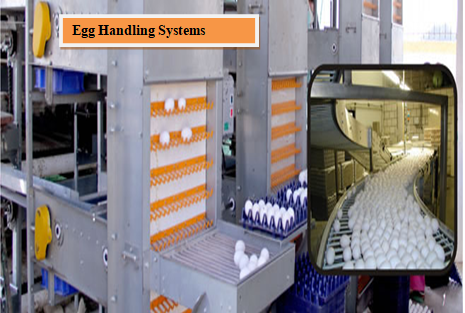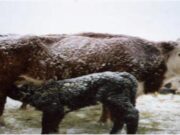
Highlights Points:
Automation is the technique or system of operating or controlling a process by highly automatic means and reducing human intervention to a minimum or using any machine that performs repetitive tasks with some degree of automation.
Automation is used in many different industrial situations to relieve human physical and/or mental effort while improving efficiency of production. Equally important, automation can work in situations that may be hazardous to humans.
Many tasks in the poultry industry were traditionally labour intensive and involved repetitive actions by people, for example checking birds for health and welfare, feeding birds, collecting eggs and removing manure.
While automation has enabled some of these tasks to be performed more easily to a certain degree, other tasks have been automated completely, reducing the need for close supervision by humans.
Introduction:
Historically, the chicken industry began in New England, USA but quickly moved to the west coast and south of USA, mainly due to the warm weather. the first cage installations in early 1950’s as the demand of eggs grew and this need for higher stocking density made early producers think of ways to accommodate more number of birds in the same area. Thus came the first modern battery which was called Pyramid type batteries or California cage simply because they were first introduced in California. Thus California became the hotbed of American poultry industry and the first multitier cages were produced, allowing to double or triple the number of birds in same house
Uses of Automation
Provide proper housing for the birds, Transport, handle and pack eggs ,Water the birds, Manage environment inside the poultry house, Feed the birds ,Remove poultry manure from the house
Modern Housing And The Beginning of Automation
Up until 1950 layer birds were housed on floors instead of cages, just like broilers. Commercial farming was a new concept and most of the farms were backyard farms with a few hundred birds. Even on commercial farms the birds used to be reared on the floor which caused various problems like coccidiosis. But farmers quickly discover that they could house layer hens in wire mesh cages suspended over a pit to collect droppings. This was well and truly the first step the layer industry took towards automation.
For Metabolism: Water is involved in every aspect of poultry metabolism. It plays important roles in regulating body temperature, digesting food, and eliminating body wastes. At normal temperatures, poultry consume at least twice as much water as feed. When heat stress occurs, water consumption will double or quadruple.
The Essential Nutrient: Water is often taken for granted, and yet it is probably the most essential nutrient. Water far the single greatest constituent of the body represents about 70% of total body weight. Access to water is very important, and a lack of water for several hours will probably cause a decline in egg production. Hens are more sensitive to a lack of water than a lack of feed.

Amount of Water Needed: Water and food consumption rates are interdependent, so reduced water intake can also lead to reduced food intake. There are other factors that affect water intake, with temperature being the most obvious one. Water intake is also affected by the type of drinkers used. The rule of thumb for water intake is that water intake is usually 1.5 to 2 times feed intake.
For Digestion: Water in the crop softens the feed so that digestion can occur.
For Egg Production: An egg consists of approximately 75% water and without access to a regular, clean supply of water, a hen will be physically unable to produce eggs. Thus one of the early automations invented for the egg industry was the simple Nipple drinker.
•The main purpose of the drinking systems is the supply of clean, fresh and adequate drinking water to your birds. advantages of an automated drinking system, below listed are the main features:
• Better hygiene ,Better control of water temperature , Minimum of water spillage; The drinking system is easy to clean and flush by means of incorporated manual or optionally automatic flushing system. Easy access for birds to the drinking water. Optimal dosing of medication or other additives to the drinking water. Better control of litter quality (dry) . Lower humidity and less ammonia in the poultry house.

Automation – Feeding Systems:
An important part of raising chickens is feeding – feeding makes up the major cost of production and good nutrition is reflected in the bird’s performance and its products.when it comes to egg farming the feeding is even more critical in the Pullet stage than it is during the laying stage
Egg Handling Systems :
Hen health and egg quality are the top two priorities on egg farms all day, every day. Egg farmers follow guidelines to ensure the hens are provided with nutritious feed, clean water, proper lighting and fresh air.
• Light, housing, diet and health are very important to the production process in order to provide high-quality eggs, and therefore, very important to the egg farmer.
•Preserving safety and quality throughout the gathering, inspecting, packaging and handling process is immensely critical and thus so is the need for automation.
• To understand the importance of automation in egg handling let us take a quick look into the process chain of Egg Collection which includes the following phases:
Laying: Hens lay eggs in a controlled environment and are fed a high-quality, nutritionally balanced diet of feed made up mostly of corn, soybean meal, vitamins and minerals to produce quality eggs.
Collecting: Some eggs are still gathered by hand, but in most production facilities, automated gathering belts do the job.


Washing: Although the hen supplies the bloom, a natural coating to protect the porous shell, in nature, the coating dries and is lost. The bloom is also lost through the egg washing process when the eggs are washed and sanitized.
Candling: The step in the grading during which the farmer (egg grader) looks inside the egg, without breaking it, to determine the quality.
Grading: Farmers classify their eggs by the size, interior and exterior quality at the time it is packed.
Sorting & Packing: Eggs are sorted according to size and should be placed large-end up in their cartons
Climate in poultry houses
The climate in poultry houses influences the wellbeing and health of humans as well as the birds. Respiratory, digestive and behavioural disorders are more likely to occur in houses in which the climatic conditions are not up to standard. The efficiency with which feed is utilised is related to the health status of the flock. Animals that are not healthy cannot be expected to perform optimally. The younger the animals are or the higher their production level, the more sensitive they become to the climatic conditions in the house. Climate can be defined as the sum of environmental factors which influence the functioning of man and animal.
The following Climatic factors must be measured at animal level:
- Temperature
- Airspeed and air movement
- Relative humidity
- Light
- Air-composition
Measuring and assessing temperature
Measuring the temperature is the most common way of assessing the climate in a house. Such a measurement can give a lot of useful information and is not expensive or hard to do. There are several ways of measuring the temperature:
1.Minimum/maximum thermometer (in every house or section of a house)
2.Temperature sensor (computerized climate control)
3.Thermometers (alcohol, electronic)
4.Infrared thermometers – electronic thermometers
Some other factors which affect the climate of the poultry house
- Humidity is controlled by the intense heating or cooling of house air in response to the temperature outside the house. When outside temperatures are low, relative humidity in the house is low, which often results in dry dust circulating in the air within the house. If the relative humidity is too high, this may result in wet litter. The ideal relative humidity for poultry is 60-80%.
- Air Composition: The most important components of air are nitrogen (N2, approximately 79%) and oxygen (O2, 20.3%). In addition to these main components there are several other gasses such as carbon dioxide (CO2), and water (H2O). Birds inhale O2 and exhale CO2 and H2O. In a poultry house some of the other harmful gases are Ammonia (NH3), Hydrogen sulphide (H2S), Carbon monoxide (CO), Sulphur dioxide (SO2). This is why it is important to ventilate the poultry house properly.
- Dust is harmful to poultry and has a negative influence on the house climate. The functioning of equipment may also be seriously hampered by dust, including heating, lighting, and ventilation, and dust has also been shown to carry microorganisms. Proper maintenance of poultry houses and regular cleaning creates more comfortable conditions for birdsand better working conditions for humans.
Advance Automation In The Poultry Industry
Automation can range from semi-automatic to fully automatic.An example of a semi-automatic system is the collection of eggs via a conveyor belt system. Although the system may automatically count the number of eggs passing a specific point, the machine does not make decisions about how it should operate.
For example, the back-up of eggs is not detected. Should a problem occur with the egg collection or transfer process, the human operator must take control. Fully automatic capability involves autonomy of decision-making. Returning to the cruise control.
The machine is programmed to respond to the increased egg weight by moving the egg collection belt forward a short distance to reduce the risk that additional eggs don’t roll into the pile and cause a problem. At least one automated egg collection system includes sensors under the egg collection belt to monitor egg weight at specific locations.
These are often at critical points such as in front of nest boxes. The information is provided to the machine’s computer control system, which has been programmed to estimate the number of eggs at the location based on weight. As the number of eggs increases so does the risk that extra eggs added to the pile may crack or break eggs, thus reducing product quality or quantity.
Some of the most advanced automation systems may incorporate some form of artificial intelligence, aided by modern computers. One or more sensors provide information to the system’s computer which processes the information, using it to make decisions.
COMPUTERISED BIRD PERFORMANCE MONITORING SYSTEM
Best friend of today’s multi-tasking farmer
All the information required like:
a) FCR
b) Mortality
c) In House Temperature
d) Humidity
e) Body Weight Of Live Stock
f) Egg Counting .and much more is just one click away.
- Reports & alarm available as text message on your mobile phone.
- Gives you virtual control over your farm, no matter where you are.
- Back in India we recently developed a software program called ‘Intelligent Egg Flow Control’, which is a system that can scan the egg conveyer or the egg collection belt for potential blockages due to excess eggs coming on at the same time and also avoid starvation of the egg conveyer due to lack of eggs. An important benefit of such as system would be that the machine would make sure that egg flow is consistent on every egg collection belt, when the conveyor belt transports the eggs to the packing area. Thus, the risk that a blockage of eggs could occur on the conveyor belt (with subsequent loss of eggs and labour time for cleaning up the mess) could be greatly reduced.
- A second system that has been implemented is ‘Accu-feed System’ which uses QTDS technology to accurately measure and discharge required grams of feed per bird in front of every cage box. And apart from discharging the required amount of feed it is also programmable to identify no. of birds per box and discharge feed accordingly.
- Millions of birds (layers and broilers) are maintained in various housing systems, so a reliable, automatic method to improve surveillance of large numbers of the birds is very relevant. Automation may be the answer, but the challenge is to determine the best way for this to be done.
- Traditional industry monitoring technologies
- Through integration of the production and health and welfare measures, farm managers would be able to continuously monitor and micro-manage their birds for optimal health, welfare and performance.

Dr.R.Shirisha , Assistant Professor, Department of Poultry Science
College of Veterinary Science, Mamnoor,Warangal



























